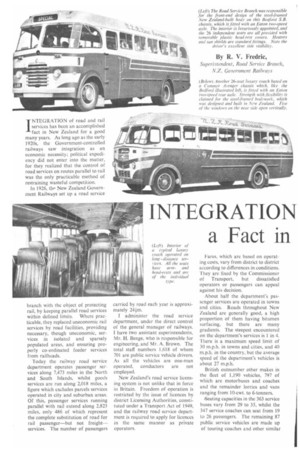INTEGRATION a Fact in ■ Iew Zealand
Page 120

Page 121

If you've noticed an error in this article please click here to report it so we can fix it.
branch with the object of protecting rail, by keeping parallel road services within defined thrifts. Where practicable, they replaced uneconomic rail services by road facilities, providing necessary, though uneconomic, services in isolated and sparsely populated areas, and ensuring properly co-ordinated feeder services from railheads.
Today the railway road service department operates passenger services along 7,473 miles in the North and South Islands, whilst goods services are run along 2,018 miles, a figure which excludes parcels services operated in city and suburban areas. Of this, passenger services running parallel with rail extend along 2,823 miles, only 486 of which represent the complete substitution of road for rail passenger—but not freight-services. The number of passengers
carried by road each year is approximately 24m.
I administer the road service department, under the direct control of the general manager of railways. I have two assistant superintendents, Mr. H. Benge, who is responsible for engineering, and Mr. A. Brown. The total staff numbers 1,618 of whom 701 are public service vehicle drivers. As all the vehicles are one-man operated, conductors are not employed.
New Zealand's road service licensing system is not unlike that in force in Britain. Freedom of operation is restricted by the issue of licences by district Licensing Authorities, constituted under a Transport Act of 1949, and the railway road service department is required to apply for licences in the same manner as private operators. Fares, which are based on operating costs, vary from district to district according to differences in conditions. They are fixed by the Commissioner of Transport, but dissatisfied operators or passengers can appeal against his decision.
About half the department's passenger services are operated in towns and cities. Roads throughout New Zealand are generally good, a high proportion of them having bitumen surfacing, but there are many gradients. The steepest encountered on the department's services is 1 in 4. There is a maximum speed limit of 30 m.p.h. in towns and cities, and 40 m.p.h. in the country, but the average speed of the department's vehicles is about 27 m.p.h.
British outnumber other makes in the fleet of 1,190 vehicles, 797 of which are motorbuses and coaches and the remainder lorries and vans ranging from 10-cwt. to 6-tonners.
'Seating capacities in the 363 service buses vary from 29 to 35, whilst the 347 service coaches can seat from 19 to 26 passengers. The remaining 87 public service vehicles are made up of touring coaches and other similar certain inter-town services, where their frequency is greater. Traffic density has not reached the stage where it presents a serious problem and time tables are virtually unaffected by it. This is not surprising because the population of New Zealand is only 24m.
(Right) Part of the route covered regularly by this Ford four-wheel-drive 14-seat bus in the South Island's beautiful district of Milfird Sounds runs through a long tunnel cut in a mountain range. The tunnel was recently widened, but before that was done there was virtually no clearance between the sides of the vehicle and the walls of the tunnel. The tubular steel frame was fitted to serve as a gauge. maintenance. Staff are often given the opportunity of acquiring knowledge of new models by special trade courses conducted by veincle manufacturers.
Vehicles are given a thorough check at intervals of 3,000 miles. This includes engine, clutch, brakes, steering, electrical equipment and running units. Lubrication is carried out at intervals of about 750 miles.
Major overhauls, in which crankshafts are normally reground, are effected at 100,000-200,000 miles, according to the make and type of vehicle. Overall tyre life, including two retreads or recaps, averages 40,000-45,000 miles.




















































































































































































































































